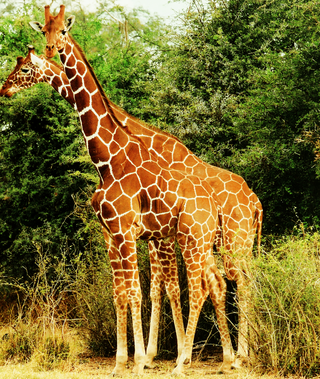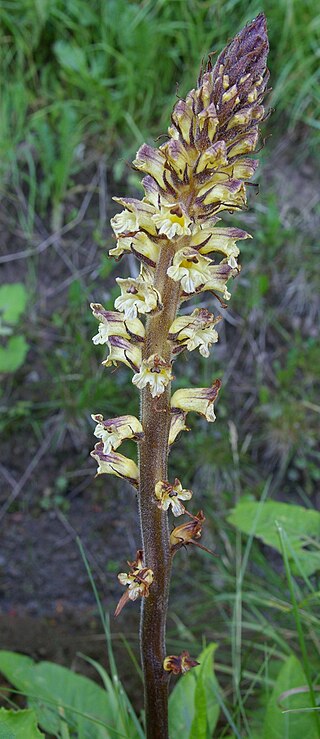
The substantia nigra (SN) is a basal ganglia structure located in the midbrain that plays an important role in reward and movement. Substantia nigra is Latin for "black substance", reflecting the fact that parts of the substantia nigra appear darker than neighboring areas due to high levels of neuromelanin in dopaminergic neurons. Parkinson's disease is characterized by the loss of dopaminergic neurons in the substantia nigra pars compacta.

Citrus is a genus of flowering trees and shrubs in the rue family, Rutaceae. Plants in the genus produce citrus fruits, including crops such as oranges, lemons, grapefruits, pomelos, and limes. The genus Citrus is native to South Asia, East Asia, Southeast Asia, Melanesia, and Australia. Various citrus species have been used and domesticated by indigenous cultures in these areas since ancient times. From there its cultivation spread into Micronesia and Polynesia by the Austronesian expansion ; and to the Middle East and the Mediterranean via the incense trade route, and onwards to Europe and the Americas.

The mandarin orange, also known as mandarin or mandarine, is a small, rounded citrus tree fruit. Treated as a distinct species of orange, it is usually eaten plain or in fruit salads. Tangerines are a group of orange-coloured citrus fruit consisting of hybrids of mandarin orange with some pomelo contribution.

Gymnophthalmidae is a family of lizards with at least 250 species, sometimes known commonly as spectacled lizards or microteiids. They are called "spectacled" because of their transparent lower eyelids, which allow them to still see with closed eyes. As in most lizards, except geckos, these eyelids are movable. The Alopoglossidae have been recently moved from this family.
Arthrosaura is a genus of spectacled lizards in the family Gymnophthalmidae.

Annona reticulata is a small deciduous or semi-evergreen tree in the plant family Annonaceae. It is best known for its fruit, called custard apple, a common name shared with fruits of several other species in the same genus: A. cherimola and A. squamosa. Other English common names include ox heart and bullock's heart. The fruit is sweet and useful in preparation of desserts, but is generally less popular for eating than that of A. cherimola.
The pars reticulata (SNpr) is a portion of the substantia nigra and is located lateral to the pars compacta. Most of the neurons that project out of the pars reticulata are inhibitory GABAergic neurons.
The pars compacta (SNpc) is one of two subdivisions of the substantia nigra of the midbrain ; it is situated medial to the pars reticulata. It is formed by dopaminergic neurons. It projects to the striatum and portions of the cerebral cortex. It is functionally involved in fine motor control.

Syringa reticulata, the Japanese tree lilac, is a species of flowering plant in the family Oleaceae native to eastern Asia, which is grown as an ornamental in Europe and North America.

The external globus pallidus combines with the internal globus pallidus (GPi) to form the globus pallidus, an anatomical subset of the basal ganglia. Globus pallidus means "pale globe" in Latin, indicating its appearance. The external globus pallidus is the segment of the globus pallidus that is relatively further (lateral) from the midline of the brain.

The guppy, also known as millionfish or the rainbow fish, is one of the world's most widely distributed tropical fish and one of the most popular freshwater aquarium fish species. It is a member of the family Poeciliidae and, like almost all American members of the family, is live-bearing. Guppies originate from northeast South America, but have been introduced to many environments and are now found all over the world. They are highly adaptable and thrive in many different environmental and ecological conditions. Male guppies, which are smaller than females, have ornamental caudal and dorsal fins. Wild guppies generally feed on a variety of food sources, including benthic algae and aquatic insect larvae. Guppies are used as a model organism in the fields of ecology, evolution, and behavioural studies.

The reticulated giraffe is a species/subspecies of giraffe native to the Horn of Africa. It is differentiated from other types of giraffe by its coat, which consists of large, polygonal, block-like spots, which extend onto the lower legs, tail and face. These prominent liver-red spots also show much less white between them, when compared to other giraffe species. While the reticulated giraffe may yet still be found in parts of its historic range, such as areas of Somalia and Ethiopia, its population stronghold is primarily within Kenya. There are approximately 8,500 individuals living in the wild.
Theodorus Willem van Lidth de Jeude was a Dutch zoologist and herpetologist. He is not to be confused with his grandfather's brother, the Dutch veterinarian and zoologist Theodoor Gerard van Lidth de Jeude (1788–1863).
Arthrosaura kockii is a species of lizard in the family Gymnophthalmidae. It is found in Suriname, French Guiana, and Brazil.
Arthrosaura montigena is a species of lizard in the family Gymnophthalmidae. It is endemic to Venezuela.
Arthrosaura synaptolepis is a species of lizard in the family Gymnophthalmidae. It is found on granite mountains in tropical forests in Venezuela and Brazil. It is also known as Donneisy's Arthrosaura.
Arthrosaura testigensis is a species of lizard in the family Gymnophthalmidae. It is endemic to Venezuelan grasslands.
Arthrosaura tyleri is a species of lizard in the family Gymnophthalmidae. The species is endemic to Venezuela.
Arthrosaura versteegii is a species of lizard in the family Gymnophthalmidae. The species is indigenous to northeastern South America.

Orobanche reticulata is a species of broomrape known by the common name thistle broomrape. It is a parasitic plant whose host is normally the creeping thistle. It is native to the lowlands of Western Europe and Central Asia, but in the United Kingdom it is a rare and protected plant, growing only in Yorkshire, on grassland sites such as Quarry Moor.









